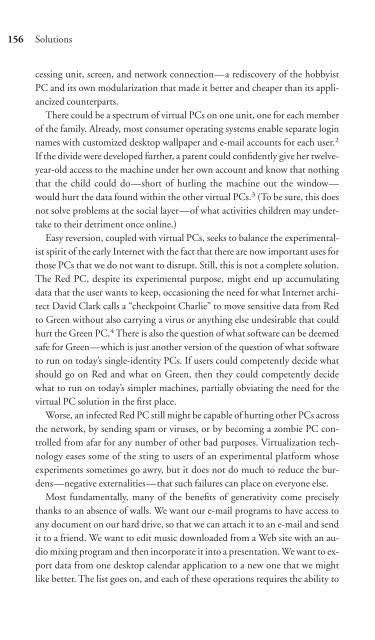Download - Future of the Internet â And how to stop it.
Download - Future of the Internet â And how to stop it.
Download - Future of the Internet â And how to stop it.
Create successful ePaper yourself
Turn your PDF publications into a flip-book with our unique Google optimized e-Paper software.
156<br />
Solutions<br />
cessing un<strong>it</strong>, screen, and network connection—a rediscovery <strong>of</strong> <strong>the</strong> hobbyist<br />
PC and <strong>it</strong>s own modularization that made <strong>it</strong> better and cheaper than <strong>it</strong>s appliancized<br />
counterparts.<br />
There could be a spectrum <strong>of</strong> virtual PCs on one un<strong>it</strong>, one for each member<br />
<strong>of</strong> <strong>the</strong> family. Already, most consumer operating systems enable separate login<br />
names w<strong>it</strong>h cus<strong>to</strong>mized desk<strong>to</strong>p wallpaper and e-mail accounts for each user. 2<br />
If <strong>the</strong> divide were developed fur<strong>the</strong>r, a parent could confidently give her twelveyear-old<br />
access <strong>to</strong> <strong>the</strong> machine under her own account and know that nothing<br />
that <strong>the</strong> child could do—short <strong>of</strong> hurling <strong>the</strong> machine out <strong>the</strong> window—<br />
would hurt <strong>the</strong> data found w<strong>it</strong>hin <strong>the</strong> o<strong>the</strong>r virtual PCs. 3 (To be sure, this does<br />
not solve problems at <strong>the</strong> social layer—<strong>of</strong> what activ<strong>it</strong>ies children may undertake<br />
<strong>to</strong> <strong>the</strong>ir detriment once online.)<br />
Easy reversion, coupled w<strong>it</strong>h virtual PCs, seeks <strong>to</strong> balance <strong>the</strong> experimentalist<br />
spir<strong>it</strong> <strong>of</strong> <strong>the</strong> early <strong>Internet</strong> w<strong>it</strong>h <strong>the</strong> fact that <strong>the</strong>re are now important uses for<br />
those PCs that we do not want <strong>to</strong> disrupt. Still, this is not a complete solution.<br />
The Red PC, desp<strong>it</strong>e <strong>it</strong>s experimental purpose, might end up accumulating<br />
data that <strong>the</strong> user wants <strong>to</strong> keep, occasioning <strong>the</strong> need for what <strong>Internet</strong> arch<strong>it</strong>ect<br />
David Clark calls a “checkpoint Charlie” <strong>to</strong> move sens<strong>it</strong>ive data from Red<br />
<strong>to</strong> Green w<strong>it</strong>hout also carrying a virus or anything else undesirable that could<br />
hurt <strong>the</strong> Green PC. 4 There is also <strong>the</strong> question <strong>of</strong> what s<strong>of</strong>tware can be deemed<br />
safe for Green—which is just ano<strong>the</strong>r version <strong>of</strong> <strong>the</strong> question <strong>of</strong> what s<strong>of</strong>tware<br />
<strong>to</strong> run on <strong>to</strong>day’s single-ident<strong>it</strong>y PCs. If users could competently decide what<br />
should go on Red and what on Green, <strong>the</strong>n <strong>the</strong>y could competently decide<br />
what <strong>to</strong> run on <strong>to</strong>day’s simpler machines, partially obviating <strong>the</strong> need for <strong>the</strong><br />
virtual PC solution in <strong>the</strong> first place.<br />
Worse, an infected Red PC still might be capable <strong>of</strong> hurting o<strong>the</strong>r PCs across<br />
<strong>the</strong> network, by sending spam or viruses, or by becoming a zombie PC controlled<br />
from afar for any number <strong>of</strong> o<strong>the</strong>r bad purposes. Virtualization technology<br />
eases some <strong>of</strong> <strong>the</strong> sting <strong>to</strong> users <strong>of</strong> an experimental platform whose<br />
experiments sometimes go awry, but <strong>it</strong> does not do much <strong>to</strong> reduce <strong>the</strong> burdens—negative<br />
external<strong>it</strong>ies—that such failures can place on everyone else.<br />
Most fundamentally, many <strong>of</strong> <strong>the</strong> benef<strong>it</strong>s <strong>of</strong> generativ<strong>it</strong>y come precisely<br />
thanks <strong>to</strong> an absence <strong>of</strong> walls. We want our e-mail programs <strong>to</strong> have access <strong>to</strong><br />
any document on our hard drive, so that we can attach <strong>it</strong> <strong>to</strong> an e-mail and send<br />
<strong>it</strong> <strong>to</strong> a friend. We want <strong>to</strong> ed<strong>it</strong> music downloaded from a Web s<strong>it</strong>e w<strong>it</strong>h an audio<br />
mixing program and <strong>the</strong>n incorporate <strong>it</strong> in<strong>to</strong> a presentation. We want <strong>to</strong> export<br />
data from one desk<strong>to</strong>p calendar application <strong>to</strong> a new one that we might<br />
like better. The list goes on, and each <strong>of</strong> <strong>the</strong>se operations requires <strong>the</strong> abil<strong>it</strong>y <strong>to</strong>


